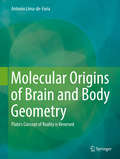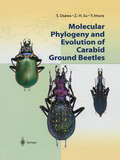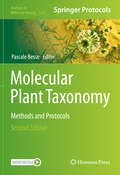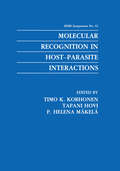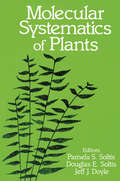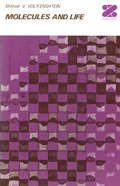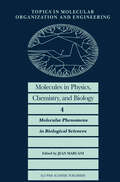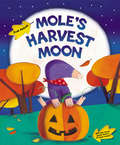- Table View
- List View
Molecular Origins of Brain and Body Geometry: Plato's Concept of Reality is Reversed
by Antonio Lima-de-FariaNew concepts arise in science when apparently unrelated fields of knowledge are put together in a coherent way. The recent results in molecular biology allow to explain the emergence of body patterns in animals that before could not be understood by zoologists.There are no ”fancy curiosities” in nature. Every pattern is a product of a molecular cascade originating in genes and a living organism arises from the collaboration of these genes with the outer physical environment.Tropical fishes are as startling in their colors and geometric circles as peacocks. Tortoises are covered with the most regular triangles, squares and concentric circles that can be green, brown or yellow. Parallel scarlet bands are placed side by side of black ones along the body of snakes. Zebras and giraffes have patterns which are lessons in geometry, with their transversal and longitudinal stripes, their circles and other geometric figures. Monkeys, like the mandrills, have a spectacularly colored face scarlet nose with blue parallel flanges and yellow beard.All this geometry turns out to be highly molecular. The genes are many and have been DNA sequenced. Besides they not only deal with the coloration of the body but with the development of the brain and the embryonic process. A precise scenario of molecular events unravels in the vertebrates.It may seem far-fetched, but the search for the origin of this geometry made it mandatory to study the evolution of matter and the origin of the brain. It turned out that matter from its onset is pervaded by geometry and that the brain is also a prisoner of this ordered construction. Moreover, the brain is capable of altering the body geometry and the geometry of the environment changes the brain.Nothing spectacular occurred when the brain arrived in evolution. Not only it came after the eye, which had already established itself long ago, but it had a modest origin. It started from sensory cells on the skin that later aggregated into clusters of neurons that formed ganglia. It also became evident that pigment cells, that decide the establishment of the body pattern, originate from the same cell population as neurons (the neural crest cells). This is a most revealing result because it throws light on the power that the brain has to rapidly redirect the coloration of the body and to change its pattern.Recent experiments demonstrate how the brain changes the body geometry at will and within seconds, an event that could be hardly conceived earlier. Moreover, this change is not accidental it is related to the surrounding environment and is also used as a mating strategy. Chameleons know how to do it as well as flat fishes and octopuses. No one would have dared to think that the brain had its own geometry. How could the external geometry of solids or other figures of our environment be apprehended by neurons if these had no architecture of their own? Astonishing was that the so called ”simple cells”, in the neurons of the primary visual cortex, responded to a bar of light with an axis of orientation that corresponded to the axis of the cell’s receptive field.We tend to consider our brain a reliable organ. But how reliable is it? From the beginning the brain is obliged to transform reality. Brain imagery involves: form, color, motion and sleep.Unintentionally these results led to unexpected philosophical implications. Plato’s pivotal concept that ”forms” exist independently of the material world is reversed. Atoms have been considered to be imaginary for 2,000 years but at present they can be photographed, one by one, with electron microscopes.The reason why geometry has led the way in this inquiry is due to the fact that where there is geometry there is utter simplicity coupled to rigorous order that underlies the phenomenon where it is recognized. Order allows variation but imposes at the same time a canalization that is patent in what we call evolution.
Molecular Pathogenesis of Gastrointestinal Infections (F.E.M.S. Symposium Series #58)
by T. Wadström P. Helena Mäkelä A. M. Svennerholm H. Wolf-WatzThe meeting that provided the material for this book was the 58th Symposium of the Federation of European Microbiological Societies (FEMS) entitled MOLECULAR PATHOGENESIS OF GASTROINTESTINAL INFECTIONS which was held in Helsingor, Denmark from 2nd to 4th September, 1990. The aim of this meeting was to bring together scientists from a range of discipline- microbiology, cell biology, molecular biology and immunology - to consider how microbes, including parasites, colonize and infect the gastrointestinal tract. The programme was designed to focus particular attention on the range of strategies whereby enterovirulent bacteria and parasites colonize the gastrointestinal mucin layer, how they adhere to and penetrate the epithelial layer by entering the cells or passing between them, and how various protein toxins may facilitate these processes. Speakers were especially encouraged to highlight the recent expansion in our knowledge of the molecular mechanisms by which enterotoxigenic and enteropathogenic Escherichia coli, shigellae, salmonellae and Yersinia enterocolitica cause intestinal disease. There were also discussions of recently-discovered gastrointestinal pathogens such as Clostridium difficile and Helicobacter pylori as well as accounts of how virulent determinants can be used to develop new diagnostic methods based on DNA gene probes and the polymerase chain reaction (PCR). These presentations provided the basis for the chapters in this book.
Molecular Phylogeny and Evolution of Carabid Ground Beetles
by S. Osawa Z.-H. Su Y. ImuraCarabid ground beetles, sometimes called "walking jewels", are among the most thoroughly investigated insects in the world. This book presents the results of molecular phylogenetic analyses of 2000 specimens, including 350 species and that cover more than 90% of the known genera, from 500 localities in 35 countries. These comprehensive analyses using mitochondrial DNA-based dating suggest that carabid diversification took place about 40 to 50 million years ago as an explosive radiation of the major genera, coinciding with the collision of the Indian subcontinent and Eurasian land mass. The analyses also lead to surprising conclusions suggesting discontinuous evolution and parallel morphological evolution. With numerous color illustrations, this book presents readers with the dynamic principles of evolution and the magnificent geographic history of the earth as revealed by the study of beetles.
Molecular Physiology and Evolution of Insect Digestive Systems (Entomology in Focus #7)
by Walter R. Terra Clelia Ferreira Carlos P. SilvaThis book provides a unique blend of data on insect life spans, physiology, enzymology and other molecular features associated with digestion and nutrient absorption to enrich the knowledge on insects and to disclose putative molecular targets for the development of new insect control technologies and for improving insect raising procedures to be used as food and feed. With this aim, the book overviews the types of diets consumed by insects, describing their chemical components demanding digestion and discusses the evolutionary selective pressures on insects associated with feeding. Digestive enzymes are classified and detailed according to their activity on substrates and their evolutionary protein families. The technical details on how to obtain reliable enzymological parameters are discussed. The book reviews the structural changes in enzymes associated with the adaptation of insects to new diets and in avoiding natural plant inhibitors. Midgut features that enhance digestive and nutrient absorption efficiency and their underlying molecular mechanisms are described regarding insects pertaining to key points in evolution. Evolutionary trends of the mechanisms of digestion and nutrient absorption are discussed.
Molecular Plant Taxonomy: Methods and Protocols (Methods in Molecular Biology #2222)
by Pascale BesseThis fully updated edition explores conceptual as well as technical guidelines for plant taxonomists and geneticists, such as the increasing use of next-generation sequencing (NGS) technologies for numerous applications in plant taxonomy. The volume provides molecular approaches to be used within an “integrative taxonomy” framework, combining a range of nucleic acid and cytogenetic data together with other crucial information (taxonomy, morphology, anatomy, ecology, reproductive biology, biogeography, paleobotany, etc.), which will help not only to best circumvent species delimitation but also to resolve the evolutionary processes in play. Written for the highly successful Methods in Molecular Biology series, chapters include introductions to their respective topics, lists of the necessary materials and reagents, step-by-step, readily reproducible laboratory protocols, and tips on troubleshooting and avoiding known pitfalls. Authoritative and up-to-date, Molecular Plant Taxonomy: Methods and Protocols, Second Edition is an ideal guide for researchers seeking a better understanding of evolutionary processes, at species and population level, through molecular techniques.
Molecular Recognition in Host-Parasite Interactions (F.E.M.S. Symposium Series #61)
by Timo K. Korhonen Tapani Hovi P. Helena MäkeläA very early step in microbial colonization and pathogenesis is that involving recog nition of the host by the microbe. In the final analysis such recognition is due to interaction between specific molecules on the two sides, without which host and microbe would ignore each other. It is therefore exciting to learn the rules that govern host-microbe interaction at to a large extent determines whether or not we are infected by the molecular level, which influenza virus, leishmanias, staphylococci and other pathogens. This book is a compendium of the addresses delivered at a symposium on molecular interaction at Porvoo, Finland in August 1991. Realizing that there are no a priori differ ences in receptor recognition in viruses, eukaryotic parasites and bacteria, we freely inter mingled these microbes at the symposium, and in this book. We found the interdisciplinary discussions and comparisons both educative and stimulating. Thus the book is divided into parts that focus on host cell receptors, on microbial recognition molecules and molecules that mediate microbial interaction with a host cell receptor and, briefly, on the molecular events that follow. Although many microbes and many cellular receptors are missing from the book -owing to the limited duration and size of the symposium -the articles presented here constitute an impressive body of examples of how initial host-microbe interaction can come about. We believe that as such the book is a useful and interesting overview of the mechanisms and principles involved in these interactions.
Molecular Signaling and Regulation in Glial Cells: A Key to Remyelination and Functional Repair
by Gunnar Jeserich Hans H. Althaus Christiane Richter-Landsberg Rolf HeumannAn excellent survey of the most recent advances in the area of cellular and molecular biology of glial cells and their involvement in remyelination and functional repair in the CNS. A major part of this book deals with signaling paths within and among neural cells. Glial cells (astrocytes, oligodentrocytes, microglial cells) themselves release substantial amounts of cytokines, growth factors and other signaling molecules, which play an important role during injury and regeneration. Another signaling route between neurons and glial cells follows ion channels and neurotransmitter receptors. In addition to animal models, human oligodentrocytes in cell culture and in the human MS brain are characterized with respect to their immunocytochemistry and function.
Molecular Systematics of Plants
by Pamela S. Soltis Douglas E. Soltis J. J. DoyleThe application of molecular techniques is rapidly transforming the study of plant systematics. The precision they offer enables researchers to classify plants that have not been subject to rigorous classification before and thus allows them to obtain a clearer picture of evolutionary relationships. Plant Molecular Systematics is arranged both conceptually and phylogenetically to accommodate the interests not only of general systematists, but also those of people interested in a particular plant family. The first part discusses molecular sequencing; the second reviews restriction site analysis and the sequencing of mitochondrial DNA. A third section details the analysis of ribosomal DNA and chloroplast DNA. The following section introduces model studies involving well-studied families such as the Onagraceae, Compositae and Leguminosae. The book concludes with a section addressing theoretical topics such as data analysis and the question of morphological vs. molecular data.
Molecular Systematics of Plants II: DNA Sequencing
by Pamela Soltis J.J. DoyleIn the five years since the publication of Molecular Systematics of Plants, the field of molecular systematics has advanced at an astonishing pace. This period has been marked by a volume of new empirical data and advances in theoretical and analytical issues related to DNA. Comparative DNA sequencing, facilitated by the amplification of DNA via the polymerase chain reaction (PCR), has become the tool of choice for molecular systematics. As a result, large portions of the Molecular Systematics of Plants have become outdated. Molecular Systematics of Plants II summarizes these recent achievements in plant molecular systematics. Like its predecessor, this completely revised work illustrates the potential of DNA markers for addressing a wide variety of phylogenetic and evolutionary questions. The volume provides guidance in choosing appropriate techniques, as well as appropriate genes for sequencing, for given levels of systematic inquiry. More than a review of techniques and previous work, Molecular Systematics of Plants II provides a stimulus for developing future research in this rapidly evolving field. Molecular Systematics of Plants II is not only written for systematists (faculty, graduate students, and researchers), but also for evolutionary biologists, botanists, and paleobotanists interested in reviewing current theory and practice in plant molecular systematics.
Molecular Techniques in Taxonomy (Nato ASI Subseries H: #57)
by Godfrey M. Hewitt Andrew W. B. Johnston J. Peter W. YoungTaxonomy is fundamental to understanding the variety of life forms, and exciting expansions in molecular biology are re- volutionising the obtained data. This volume reviews the ma- jor molecular biological techniques that are applied in ta- xonomy. The chapters are arranged in three main sections:1) Overviews of important topics in molecular taxonomy; 2) Case studies of the successful application of molecular methods to taxonomic and evolutionary questions; 3) Protocols for a range of generally applicable methods. The described techni- ques include DNA-DNA hybridization, DNA fingerprinting, RFLP analysis, and PCR sequencing.
Molecular Tools for Screening Biodiversity: Plants and Animals
by A. Karp D. S. Ingram Peter G. IsaacMark Chase There are many literature resources available to molecular biologists wishing to assess genetic variation, but the myriad of techniques and approaches potentially available to the plant breeder and the evolutionary biologist is truly bewildering, and most have never been evaluated side-by-side on the same sets of samples. Additionally, it is often not recognized that tools that are useful for breeders can often be adapted for use in evolutionary studies and vice versa, but this is generally the case. The borderline between population genetics and phylogenetics is vague and difficult to assess, and a combination of both types of tools is best when it is not clear with which area one is dealing. Furthermore, it is not now appropriate to use just one type of marker in any kind of study; most markers have the potential to misinform under certain conditions, so it is always wise to incorporate at least two different types of assessments into any project. This volume is designed to facilitate this sort of multiple approach and provides comparative data on most currently available methods so that researchers can more intelligently select those appropriate to their area of interest, regardless of whether it is in the realm of breeding or evolutionary biology.
Molecular Toxicology in Caenorhabditis elegans
by Dayong WangThis book will focus on the molecular basis of oxidative stress induced by toxicants or stresses and various molecular signalling pathways in regulating the toxicity of toxicants or stresses in Caenorhabditis elegans. It will also cover the discussion on the aspects of response signals, G-protein coupled receptors and ion channels, specific molecular signals, and epigenetic signals involved in the regulation of toxicity from toxicants or stresses. The molecular basis for adaptive response for transgenerational toxicity of environmental toxicants or stresses will be further discussed. Nematode Caenorhabditis elegans is a classic model animal with well-described genetic and developmental backgrounds based on the study of life science, and has been further successfully and widely used in both toxicity assessment and toxicological study of various environmental toxicants or stresses. Based on related available data, this book aims at providing a systematic understanding of the knowledge system of molecular toxicology in C. elegans.
Molecularly Targeted Therapy for Childhood Cancer
by Peter J. Houghton Robert J. ArceciEach chapter will focus on the known molecular characteristics of specific childhood cancers, focusing on how the molecular ‘drivers’ can be exploited from a therapeutic standpoint with currently available targeted agents. Where applicable, integration of targeted therapies with conventional cytotoxic agents will be considered. This volume will provide a comprehensive summary of molecular characteristics of childhood cancers, and how the changes involved in transformation provide us with opportunities for developing relatively less toxic, but curative, therapies.
Molecules and Life: An Introduction to Molecular Biology
by Mikhail V. Vol kenshteinacids. The achievements of molecular biology testify to the success of material science in a realm which, until recently, appeared totally enig matic and mysterious. Further scientific developments should bring to mankind vast developments both in theoretical knowledge and in practical applications, namely, in agriculture, medicine, and technology. The purpose of this book is to explain molecular biophysics to all who might wish to learn about it, to biologists, to physicists, to chemists. This book contains descriptive sections, as well as sections devoted to rigorous mathematical treatment of a number of problems, some of which have been studied by the author and his collaborators. These sections may be omitted during a first reading. Each chapter has a selected bibliography. This book is far from an exhaustive treatise on molecular biophysics. It deals principally with questions related to the structures and functions of proteins and nucleic acids. M. V. Vol'kenshtein Leningrad, September, 1964 CONTENTS Chapter 1 Physics and Biology. . . . . . . . . . . . . . . . . . . . . . . . . . . . . . . . . . . . . . . 1 Physics and Life. . . . . . . . . . . . . . . . . . . . . . . . . . . . . . . . . . . . . . . . 1 Molecular Physics. . . . . . . . . . . . . . . . . . . . . . . . . . . . . . . . . . . . . . 3 Molecular Biophysics ................................... 9 Thermodynamics and Biology. . . . . . . . . . . . . . . . . . . . . 12 . . . . . . . Information Theory. . . . . . . . . . . . . . . . . . . . . . . . . . . 19 . . . . . . . . . . Chapter 2 Cells, Viruses, and Heredity. . . . . . . . . . . . . . . . . . . . . . . . 27 . . . . . . . . The Living Cell. . . . . . . . . . . . . . . . . . . . . . . . . . . . . . 27 . . . . . . . . . . . Cell Division. . . . . . . . . . . . . . . . . . . . . . . . . . . . . . . 37 . . . . . . . . . . . . Viruses and Bacteriophages ........... . . . . . . . . . . . . . . . 44 . . . . Basic Laws of Genetics . . . . . . . . . . . . . . . . . . . . . . . . . 50 . . . . . . . . . Mutations and Mutability ........ , ................. " . . . . 60 Genetics of Bacteria and Phages " . . . . . . . . . . . . . . . . . . 66 . . . . . . Chapter 3 Biological Molecules. . . . . . . . . . . . . . . . . . . . . . . . . . . . 79 . . . . . . . . . . Amino Acids and Proteins . . . . . . . . . . . . . . . . . . . . . . . 79 . . . . . . . . Asymmetry of Biological Molecules ....................... 87 Primary Structure of Proteins ............................ 94 Nucleic Acids . . . . . . . . . . . . . . . . . . . . . . . . . . . . . . 101 . . . . . . . . . . . . Some Biochemical Processes in the Cell. . . . . . . . . . . . . . . . 109 . . . . Chapter 4 Physics of Macromolecules. . . . . . . . . . . . . . . . . . . . . . . . 123 . . . . . . . . .
Molecules in Physics, Chemistry, and Biology: Physical Aspects of Molecular Systems (Topics in Molecular Organization and Engineering #2)
by J. MaruaniVolume 1: General Introduction to Molecular Sciences Volume 2: Physical Aspects of Molecular Systems Volume 3: Electronic Structure and Chemical Reactivity Volume 4: Molecular Phenomena in Biological Sciences
Molecules in Physics, Chemistry, and Biology: General Introduction to Molecular Sciences (Topics in Molecular Organization and Engineering #1)
by J. MaruaniVolume 1: General Introduction to Molecular Sciences Volume 2: Physical Aspects of Molecular Systems Volume 3: Electronic Structure and Chemical Reactivity Volume 4: Molecular Phenomena in Biological Sciences
Molecules in Physics, Chemistry, and Biology: Electronic Structure and Chemical Reactivity (Topics in Molecular Organization and Engineering #3)
Volume 1: General Introduction to Molecular Sciences Volume 2: Physical Aspects of Molecular Systems Volume 3: Electronic Structure and Chemical Reactivity Volume 4: Molecular Phenomena in Biological Sciences
Molecules in Physics, Chemistry, and Biology: Molecular Phenomena in Biological Sciences (Topics in Molecular Organization and Engineering #4)
Volume 1: General Introduction to Molecular Sciences Volume 2: Physical Aspects of Molecular Systems Volume 3: Electronic Structure and Chemical Reactivity Volume 4: Molecular Phenomena in Biological Sciences
Molekulare Populationsgenetik: Theoretische Konzepte und empirische Evidenz
by Wolfgang Stephan Anja C. HörgerDas Buch behandelt die genetische Vielfalt von Populationen von Organismen. Es erläutert, wie genetische Vielfalt gemessen wird und wie aus diesen Daten die Mechanismen untersucht werden können, die die Variabilität auf der Genomebene und damit die Mikroevolution einer Population beeinflussen. Ziel dieses Buches ist es, das Wirken der natürlichen Selektion im Genom zu verstehen und vom Einfluss neutraler Evolutionskräfte (wie genetischer Drift, Mutation und Rekombination) unterscheiden zu lernen. Dazu werden die grundlegenden theoretischen Konzepte der Populationsgenetik eingeführt und anhand von zahlreichen Beispielen aus allen Organismengruppen (Menschen, Tieren, Pflanzen und Mikroorganismen) veranschaulicht. Um das Verständnis der theoretischen Ableitungen von Hypothesen und der darauf basierenden Datenanalysen zu überprüfen und weiter zu vertiefen, schließt jedes Kapitel mit Übungsaufgaben und Lösungen ab.
Molekulare Virologie
by Susanne Modrow Dietrich Falke Uwe Truyen Hermann SchätzlVom Gen zur Pathogenese Das Lehrbuch Molekulare Virologie, seit vielen Jahren als unentbehrliches Standardwerk für Fachleute und Studenten etabliert, liegt nun wieder in einer überarbeiteten und erweiterten Neuauflage vor. Neben der durchgängigen Aktualisierung der Inhalte und Literaturzitate sind unter anderem Layout und Format des Buches angepasst sowie die eingestreuten Exkurse, die schlaglichtartig interessante Einzelthemen beleuchten, thematisch differenziert worden. Durch Einbindung eines zusätzlichen Autors sind zudem humanmedizinisch-klinische Aspekte nun noch stärker berücksichtigt. Molekulare Virologie ist eine Einführung in die molekular- und zellbiologischen Grundlagen von Virusinfektionen bei Mensch und Tier. Das Buch vermittelt einen ausgewogenen Überblick über humanpathogene und tierpathogene Viren. Mit seiner klaren Gliederung und verständlichen Darstellung weist dieses systematisch angelegte Lehr- und Nachschlagewerk sowohl Studenten und Dozenten der Biologie, Human- und Veterinärmedizin als auch Virologen, forschungsorientierten Klinikern, Tierärzten und Seuchenmedizinern sowie Fachleute in Mikrobiologie, Hygiene und Diagnostik den Weg durch die Vielfalt der virologischen Forschungsergebnisse. Im ersten Teil des Buches arbeiten die Autoren die allgemeinen Prinzipien der Struktur, Vermehrung und Lebenszyklen von Viren heraus und beschreiben die wichtigsten pathogenetischen und immunologischen Mechanismen viraler Erkrankungen. Auch die Diagnostik und Therapie sowie die Epidemiologie solcher Infektionen und das heutige Methodenrepertoire der Virologen werden hier vorgestellt. Der zweite, spezielle Teil führt dann systematisch durch die Vielfalt der human- und tierpathogenen Viren. Ausführlich werden zum einen die Morphologie, die Genomorganisation und die Proteinaustattung sowie die Replikationsmechanismen der verschiedenen Virusfamilien dargestellt. Für die jeweils wichtigsten Vertreter präsentieren die Autoren zum anderen einen Überblick über die relevanten humanmedizinisch-klinischen beziehungsweise veterinärmedizinischen Aspekte. Auch seuchenrechtliche Aspekte kommen hier zur Sprache. Dem Autorenteam gelingt es mit diesem Werk erneut, Virologie in ihrer ganzen Spannbreite - vom Molekül bis zur Klinik - überschaubar zu machen. Mit der konsequenten Verknüpfung dieser beiden Zugänge schlägt dieses Werk zudem dringend benötigte Brücken zwischen (molekular)biologischer Grundlagenforschung und medizinischer Anwendung.
Molekulare Virologie
by Hermann Schätzl Susanne Modrow Uwe TruyenDieses bewährte Standardwerk vermittelt einen ausgewogenen Überblick über die bekannten humanpathogenen und tierpathogenen Viren, wie beispielsweise Papilloma- und Influenzaviren und wurde ergänzt um die eher neu aufgetretenen Viren, insbesondere Zikavirus, das neuartigen Coronavirus SARS-CoV-2 und das Schmallenberg-Virus, einem Bunyavirus, das Rinder, Schafe und Ziegen infiziert.Der erste Teil des Buches präsentiert die allgemeinen Prinzipien der Struktur, Vermehrung und Lebenszyklen von Viren und beschreibt die wichtigsten pathogenetischen und immunologischen Mechanismen viraler Erkrankungen. Auch die Diagnostik und Therapie sowie die Epidemiologie solcher Infektionen und das heutige Methodenrepertoire der Virologen werden hier vorgestellt.Der zweite, spezielle Teil führt systematisch durch die Vielfalt der human- und tierpathogenen Viren. Ausführlich dargestellt sind hier Morphologie, Genomorganisation, Proteinausstattung sowie Replikationsmechanismen der verschiedenen Virusfamilien. Für die jeweils wichtigsten Vertreter liefern die Autoren einen Überblick über die relevanten humanmedizinisch-klinischen beziehungsweise veterinärmedizinischen Aspekte. Auch seuchenrechtliche Fragen kommen hier zur Sprache.Das Lehrbuch dient seit vielen Jahren als bewährte Einführung in die molekular- und zellbiologischen Grundlagen der Virologie und ist unentbehrlich für Fachleute und Studierende. Die 4. Auflage wurde ergänzt mit den aktuellen Daten zu den jeweiligen Viren und bietet somit einen aktuellen Überblick zu den Replikationsstrategien und verbindet diese mit der Pathogenese der Erreger. Integriert wurden Virusspezies, die während der vergangenen Jahre neu aufgetreten sind und in vieler Hinsicht die öffentliche Diskussion beherrscht haben. Nicht zuletzt zählen hierzu die Infektionen des Menschen mit dem neuartigen Coronavirus SARS-CoV-2, dem Zikavirus, den tier- wie humanpathogenen Bornaviren sowie dem Schmallenberg-Virus, dessen Infektion bei Wiederkäuern schwere Fetopathien verursacht. Mit seiner klaren Gliederung und verständlichen Darstellung weist dieses systematisch angelegte Lehr- und Nachschlagewerk• Studierenden und Lehrenden in Biowissenschaften, Human- und Veterinärmedizin• Virologen, forschungsorientierten Klinikern, Tierärzten und Seuchenmedizinern sowie• Fachleuten in Mikrobiologie, Hygiene und Diagnostikden Weg durch die Vielfalt der virologischen Forschungsergebnisse.
Mole's Harvest Moon
by Judi AbbotBear, Mouse and Rabbit are foraging for ingredients for Mole's harvest feast. But as darkness falls they realise they are being followed! Only the light of the harvest moon and their own cunning will get them home - but on this spooky autumn night is everything as it seems?A lovely reassuring autumnal tale about appearances, food and friendship.
Mollusks and Marine Environments of the Ten Thousand Islands
by Edward J. Petuch David P. BerschauerMollusks and Marine Environments of the Ten Thousand Islands provides the first comprehensive overview of the shells and habitats that are present in the last unexplored coastal area of southwestern Florida. The mysterious and primordial Ten Thousand Islands, where the rivers and marshlands of the Everglades empty into the Gulf of Mexico, house a number of remarkable marine ecosystems, many shown here in detail for the first time. Primary among these are unique worm shell “reef systems,” composed entirely of immense masses of vermetid gastropod mollusks. These previously unexplored and unstudied gastropod reefs, which are often many acres in size, are shown here to mimic coral reefs in their growth structure and represent the only large-scale molluscan reefs found anywhere on Earth. Living in association with the zonated gastropod reefs are a number of rare and unusual mollusks, some of which represent endemic species that are unique to the Ten Thousand Islands. These and many other southwestern Florida shells are illustrated throughout this book, along with detailed illustrations and descriptions of the marine and estuarine environments that dominate the archipelago and its adjacent lagoon systems.
Mollusks and Marine Environments of the Ten Thousand Islands
by Edward J. Petuch David P. BerschauerMollusks and Marine Environments of the Ten Thousand Islands provides the first comprehensive overview of the shells and habitats that are present in the last unexplored coastal area of southwestern Florida. The mysterious and primordial Ten Thousand Islands, where the rivers and marshlands of the Everglades empty into the Gulf of Mexico, house a number of remarkable marine ecosystems, many shown here in detail for the first time. Primary among these are unique worm shell “reef systems,” composed entirely of immense masses of vermetid gastropod mollusks. These previously unexplored and unstudied gastropod reefs, which are often many acres in size, are shown here to mimic coral reefs in their growth structure and represent the only large-scale molluscan reefs found anywhere on Earth. Living in association with the zonated gastropod reefs are a number of rare and unusual mollusks, some of which represent endemic species that are unique to the Ten Thousand Islands. These and many other southwestern Florida shells are illustrated throughout this book, along with detailed illustrations and descriptions of the marine and estuarine environments that dominate the archipelago and its adjacent lagoon systems.
